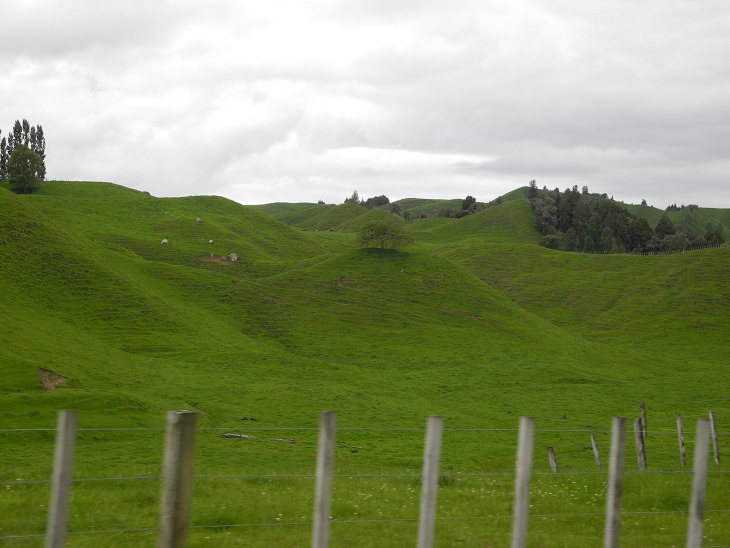Thermally Amazing!
Our journey also included a different type of giant, as we next
drove towards Lake Taupo, an approximately 30km by 30km interior lake that
fills the caldera of the enormous Mt. Taupo, the largest eruption of which was about
26,500 years ago and affected sunsets, etc. all over the world. These pictures
are overlooking from the south and then from the eastern lakeshore on two
consecutive days.
The volcano in the background is Mt. Tongariro, the one that decided to do housecleaning last week! We stayed one night in the town of Taupo, and then undertook
a walk along the Waikato River to see the impressive Huka Falls before we
departed for Rotorua. It was a longer walk than we realised, with a lot more hills involved, but it was so worthwhile!
Rotorua is a thermally active region, much of which is
underlain by bodies of volcanically heated water, resulting in hot springs, mud
pools and geysers throughout the area. As such, it has become a very popular
destination both for those who would live with that warmth (there are several
Maori villages that have been established here for centuries) and tourists. We
took advantage of geological, cultural, and entertainment activities in a very
action-packed two days in the area. On the first evening we went to the Rotorua
Museum, which had first been an 1800’s bath and treatment spa. The treatments
ranged from soaking in lovely, hot, sulphurous baths, to some really horrific
applications of electricity! Also at the museum was an amazing exhibition of
the winning entries in the recent WOW! Wearable Art competition that took place
recently in Wellington, New Zealand. I was truly impressed with the astounding
creations on display!
First thing the next morning, we went to Wai-o-tapu, where
steaming craters, mud pools and volcanic pools can be seen, and a geyser is
triggered to erupt every day at 10:15am. While all of these features are very
impressive, my personal favourite had to be the mud pools!
Our next stop was at Whakarewarewa, a Maori village where
the members of the village have devoted their energies to educating visitors
about what it means to live a thermally based, Maori lifestyle. Some of them
performed several traditional songs and athletic demonstrations including a beautiful
love-song about two of the village’s ancestors. Another lady walked around the
village with us, telling us the history of the area, guiding us around the
thermal areas in the village (including more geysers, and the specialised
cooking facilities!) and helping us to understand how their lives are affected
by their location. The village stores are open to the public, so we happily
enjoyed some really excellent pies (Hangi) that had been volcanically prepared,
at the local café.
In the afternoon, we turned to the tourist playground side
of Rotorua. First, my son wanted to find out how it would feel to experience
free-falling without having to jump out of a perfectly good airplane. So, he
tried a free-fall simulator where they suit you up with a sort of bat-wing type of flight suit to maximise lift, before
having you lay out on a net over a huge fan—when the fan starts, up you go!
Apparently it was amazing!
Next, we went together to ride a gondola up the side of a
mountain (I have no pictures, so here's the link: http://www.skyline.co.nz/rotorua/ssr_luge/) before taking three trips on dry luge tracks down the slopes of said
mountain! I say “dry” only to indicate that there is no ice like the luges we
are used to in Canada. This one was certainly wet in the sense that the heavens
opened and we got completely drenched! (Not that that stopped us for going on
all three of our turns—we just shivered and grinned on the chair lift on the
way back up between tries, much like the mad tourists that we undoubtedly were
at the moment). Our final adventure activity for the afternoon was rolling down
a grassy hill in a giant plastic ball! They were kind enough to put in much
warmer water than the rainstorm had already provided, and had us wear
swimsuits. Much better! It was actually hilarious fun!
At the end of all this craziness, we wrapped ourselves up in
dry towels and drove back to our campsite for a lovely dip in the thermal hot
pool to warm up! It was divine!

























.jpg)
.jpg)
.jpg)











